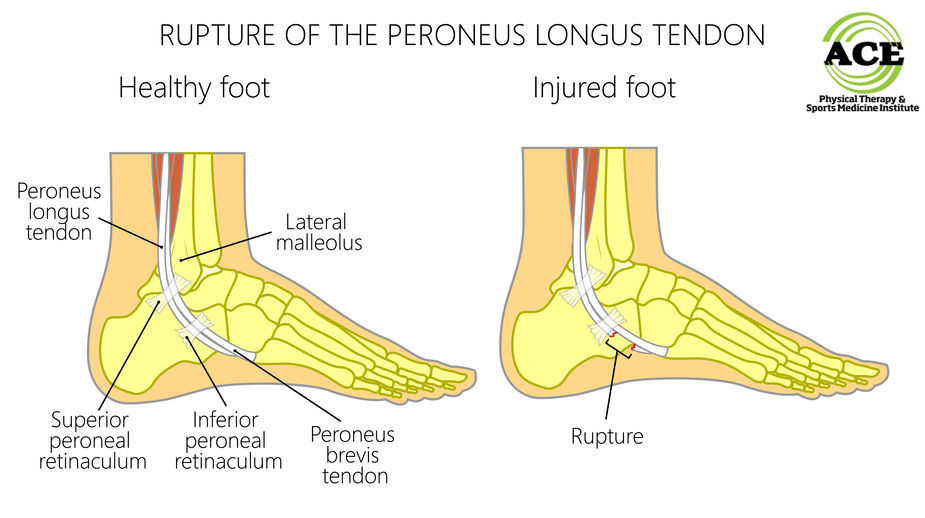PERONEAL TENDON INJURIES IN ANKLE INSTABILITY

Tid Bits of Info
- Ankle sprains occur more commonly in adolescent females compared to any other group.
- Damage to the peroneal muscle/tendon may go undiagnosed at a rate of 40% of all ankle sprains.
- 30% or more of all sports injuries occur at the ankle.
- The status of the peroneal tendon is best diagnosed via an MRI.
- Seek the advice and treatment of a Physical Therapist if you sprain your ankle.
Every day healthcare providers treat ankle sprains. Anyone can suffer from a sprain, and athletes often experience sprains due to the repetitive nature of certain activities. Peroneal tendons stabilize the foot and ankle and can help prevent ankle sprains. At the same time, a lateral ankle sprain could indicate a peroneal tendon injury, which could lead to multiple ankle sprains over a lifetime. There is an old saying that states, “Once sprained, always sprained.” Proper diagnosis and treatment is critical for short term rehabilitation and long term ankle stability.
There are two peroneal muscles that are located in the lateral compartment of the lower leg and their tendons course around the lateral malleolus. The lateral malleolus is used as a pulley system to enable these muscles/tendons to generate a greater amount of force when they contract. The forceful contraction moves the foot/ankle complex into an everted position. The lateral force is responsible for providing a dynamic stabilizing force from the lateral side. There are no other muscles that can achieve this task.
When the foot/ankle is inverted forcefully and uncontrolled, a sprain of the lateral ligaments can and usually occurs. The ligaments have a leather-like consistency and when they are forcefully stretched they often times rupture. These structures provide a static stabilizing force to the ankle. During an inversion ankle sprain, the peroneal tendons are often times “over-stretched.” When the tendon is forcefully stretched too far, damage can occur. This condition is often overlooked and undiagnosed in the acute stages of an ankle sprain due to the gross amount of swelling and pain.
As the ankle progresses from an acute sprain to sub-acute and the initial rehabilitation phase has ended, more attention needs to be placed on the status of the peroneal tendons. Peroneal tendon injuries can be classified into 3 different categories: tendinopathy, subluxation/dislocation, and splits and ruptures. In many instances, ankle sprains occur in people who have some sort of peroneal pathology that has gone undiagnosed and untreated.

Tendinopathy conditions are most common and usually respond well to conservative treatment. When someone has tendinitis or tendinosis of the peroneal tendons they will complain of pain along the lateral aspect of the ankle and many times at the site where the tendons “loop” around the lateral malleolus. There might be swelling in this area and the tendons are sore to the touch. When the tendons are stressed they are painful.
Subluxing/dislocating tendons are more difficult to treat but can be dealt with conservatively in most instances. The tendon or tendons actually lift up and out of the little groove that they course around the lateral malleolus. There different severities of this type of injury and the most severe (grade 3) involves an avulsed fragment of bone that forms the groove and this usually requires surgery to correct.
Splits and ruptures usually require surgery to fully repair. Long periods of “down time” and restricted motion can produce positive healing results, but most people choose to speed up the process by undergoing surgical repair.
Treating the peroneal tendons if they are damaged follow the basic guidelines of rehabilitation. The proper diagnosis must occur through diagnostic testing if necessary, a period of immobility or limited mobility and adjusting the amount of load that is put through the tendon(s) must occur. This is followed by a thorough rehabilitation program that addresses strengthening the core and lower extremity muscles. Re-educating the neuromuscular activity level in the ankle and finally returning the person to full activity level.
If you suffer from a sprained ankle, Physical Therapists are licensed professionals who can evaluate your ankle condition and develop an individualized rehabilitation program for you. They will make sure that your ankle moves normally and the muscles are able to provide the dynamic support by being strong and ready to “fire” when they are supposed to react. Seeking the help of a Physical Therapist does not require a doctor’s prescription but your insurance plan might require that you secure a referral from your general practitioner.
Lateral ankle sprains are extremely common but the involvement and status of the peroneal muscles and tendons is often times not diagnosed properly. Without proper attention to these muscles, an ankle remains unstable and more prone to future sprains. Fortunately, performing a well-designed rehabilitation program reduces the chances of future injury and making sure that the peroneal muscles are healthy and able to perform at full capacity.
























